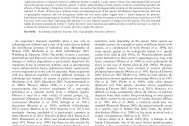Content
An organism’s ability to respond to ecological changes at its currently inhabited location, and to colonize a new one, is particularly important for organisms inhabiting ephemeral habitats. Phoresy, which involves attaching of a nonvagile individual to a selected carrier of a different species, is used by a wide variety of taxa, but surprisingly little is known about the genetic structure of phoretic species. A better understanding of their genetic structure would help elucidate the efficacy of this manner of dispersal. In this study, we analyse the phylogeographic patterns of the pseudoscorpion Chernes hahnii (C.L. Koch, 1839) across a 1830 km range, encompassing most of the species’ distribution range in Europe. The lack of geographic structure and low divergences within the two main clades suggest that Chernes hahnii disperses by phoresy. Individuals shared haplotypes at localities 350 km apart and very little divergence was detected between localities over 1450 km away from each other, indicating that phoresy is a very efficient manner of dispersal in this species. We also detected highly divergent populations within Chernes hahnii
however, more material and additional data would be necessary in order to evaluate the potential existence of cryptic diversity within this species.



